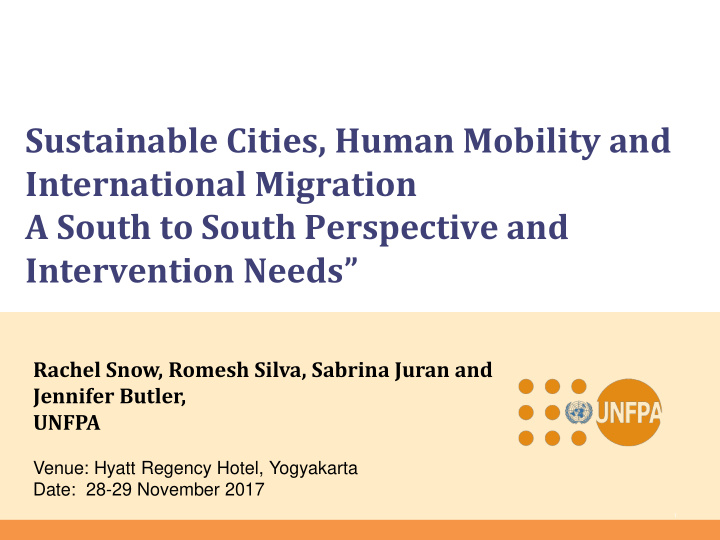



Sustainable Cities, Human Mobility and International Migration A South to South Perspective and Intervention Needs ” Rachel Snow, Romesh Silva, Sabrina Juran and Jennifer Butler, UNFPA Venue: Hyatt Regency Hotel, Yogyakarta Date: 28-29 November 2017 1
2030 Agenda: Migration 12 out of 17 Goals are relevant to migration 10+ Targets include reference to issues pertaining to migration 2
51 st CPD (2018) Theme Sustainable cities, human mobility and International Migration: future urban population growth is characterized by internal migration migration and migrants are shaping cities young people are clustering in cities mobility is a rational response to a limited future inclusive urbanisation, migrant integration, social cohesion, invest in rural areas 3
Migration and Cities 3.3% global population 48% female – Nepal (69%), Moldova (65%) 15% of international migrants < 20 yrs 34% within SSA <20 years 1 in 5 migrants live in the world’s 20 largest cities - driving force of urbanization By 2050, 66% all people in urban areas UN Population Division: Trends in International Migrant Stock: The 2015 Revision 4
Internal Migrants & the Displaced At least 763 million internal migrants (inside their country of origin) 65.6 million persons forcibly displaced worldwide as a result of conflict, violence or human rights violations – by the end of 2017 22.5 million refugees 40.3 million Internally Displaced People 2.8 million asylum seekers UN Population Division: Cross-national comparisons of internal migration UNHCR: Global Trends 2016 5
Engines of Development Global annual remittances estimated at $426 billion in 2016 – increased from $132 billion in 2000 $270 billion in Asia-Pacific alone – many times higher than ODA ; Cities are engines of development – Estimated two-thirds of total employment for migrants is informal employment UN Population Division: International Migration Report 2015 World Bank: Migration and Remittances, 2017 6
Many Drivers of Migration Environmental Political Drivers Individual/Family Drivers Discrimination/persecution characteristics Governance/freedom Exposure to hazard Age, Sex, education, wealth, marital Policy incentives Ecosystem services, incl. status, preferences, citizenship, Direct coercion - land productivity religion, language Conflict, humanitarian settings - habitability - food/energy/ water security Migrate Decision Demographic Stay Inequality Drivers Intervening factors Population size, density Population structure Political/legal framework Disease prevalence Cost of moving Social networks, Diaspora Social Recruitment agencies Economic Technology and Communication Drivers Drivers Education Employment opportunities, Family reunification Income, wages, well-being, New opportunities, challenges in rural and agriculture new possibilities sector 7
Cascade of vulnerabilities Lack of decent work Undocumented status; lack of papers No family network , limited healthcare, lack of social protection systems Slums, homelessness, poor living standards Vulnerability to trafficking, violence, criminality Complexity of returning home And there are those left behind A geing in cities and in rural areas 8
Work of UNFPA Addressing the drivers of internal and international migration ( expanding development opportunities ) Protecting those in transit Promoting non-discrimination, security, human rights at destination Improving data on human mobility Demographic dividend 9
UNFPA: Migrant Youth in Cities Analytical Focus: • drivers of youth migration • SRH service needs and accessibility issues for youth migrants Closed-ended Surveys using mobile phones In-depth interviews/FGDs Ages 15-24/18-29 UNFPA: Mixed Migration: Drivers and Implications 10
UNFPA: Migrant Youth in Cities Better data – quantitative and qualitative Rural to urban in their own country Onward movement to other countries if opportunities fail them why they moved? how they are coping? what services they need? what will motivate them to stay or move onward? 11
Must Improve the Data ! TRADITIONAL UNHCR & UNFPA NATIONAL PROTECTION POPULATION DATA - POPULATION CENSUS - HOUSEHOLD SURVEYS - ADMINISTRATIVE DATA SYSTEMS HUMANITARIAN DATA UNFPA HUMANITARIAN - UNHCR REGISTRATION POPULATION DATA DATA SYNTHESIS - IOM DISPLACEMENT TRACKING DATA - SECTOR-SPECIFIC NEEDS ASSESSMENTS DIGITAL DATA - SATELLITE IMAGERY WHO & UNFPA HEALTH - GIS DATA - REMOTE SENSING INFORMATION 12
Recommend
More recommend